The Dracaena marginata is a member of the Dracaena family (Asparagaceae), a family that provides some of the most durable indoor foliage plants used indoors in offices building, hotels, and malls but also as an everyday house plant.
Of all the Dracaenas, Dracaena marginata is probably the most versatile. Some confuse this Dracena houseplant with a palm which is why you’ll often see dracaena palm referenced.
Different forms of Dracaena marginata – character, stump, staggered, tree, colorama and dracaena flower
Although it may look palm-like as a larger specimen it is in the same family as the popular Yucca plant.
Table Of Contents
- Dracaena Marginata Care For All ‘Dragon Tree Plant’ Varieties
- Care Instructions For Watering Your “Red-Edged Dracaena”
- What Temperatures Are Best For Marginata?
- Dracaena Marginata Pests Problems?
- Dracaena Marginata Cultivars
- Dracaena Tarzan New King Of Marginata
- Dracaena Magenta
- Dracaena Marginata Tricolor
- Dragon Tree Dracaena Marginata Colorama
- Other Dracaena Species Grown For Use Indoors:
Dracaena Marginata plant goes by many different common names:
- Dracaena marginata
- Red edged dracaena
- Madagascar dragon tree Dracaena marginata
- Dragon blood tree
- Dragon plant
- Tree Dracaena plant
Add to that the marginata also has a few different ‘cultivars’:
- ‘Tarzan’
- Magenta
- Tricolor
- Colorama
Throw in a few forms th versatile popular tropical Dracaena marginata houseplant is grown in:
- Bush
- Straight cane
- Staggered cane
- Tree form
- Character forms
… And it’s easy to see why the Dracaena is one popular plant for indoor use, but outdoors as well. In general, the Dracaena marginata is rugged and carefree as an indoor plant adding a tropical appearance to any room it graces.
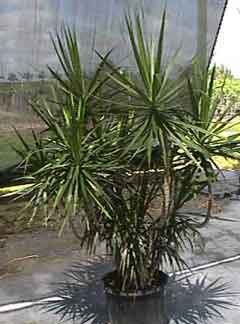 Dracaena Marginata CandelabraWhen Dracaena marginata is planted outdoors in the south Florida landscape in direct sunlight a Dracaena marginata can grow to heights of approximately 15′ foot tall.
Dracaena Marginata CandelabraWhen Dracaena marginata is planted outdoors in the south Florida landscape in direct sunlight a Dracaena marginata can grow to heights of approximately 15′ foot tall.
The leaves with red to purple stripes running along the edge find themselves sitting atop long slender “canes.” As new leaves emerge the oldest mature leaves yellow and fall off.
Details on Yellowing Leaves on Dracaena
When Dracaena marginata is grown for indoor use fields of “stock” plants are planted and the growing tips or long thin stem cuttings called “canes” are cut and rooted in well-drained soil.
The rooted plants of the Madagascar dragon tree are planted into a variety of forms and grown on for use as a houseplant or for use in commercial applications by interiorscapers or plantscapers.
The Dracaena (all types of Dragon plants) make a great focal point in a room and many designers use staggered forms or character forms to create interest.
A small footprint is one big advantage most Dracaenas provide for use as indoor plants.
You can get a tall upright 6′ foot character indoor plant or other different and unique looks, which uses very little floor space. Examples below:
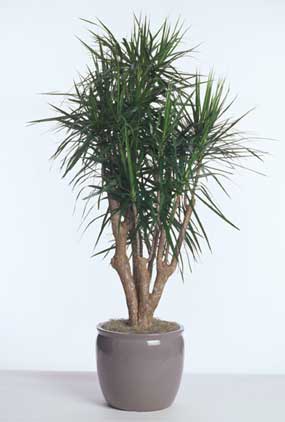 Dracaena Marginata stump
Dracaena Marginata stump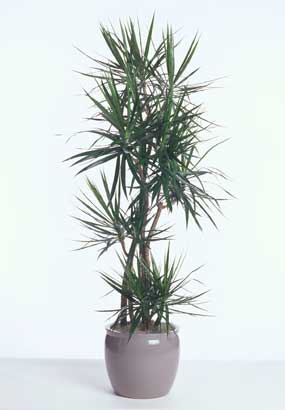 Potted Dracaena Marginata with bends and curves.Using Dracaena marginata canes of various lengths either straight, with bends and curves or multiple heads, and planting the canes together allows growers to produce fuller plants.
Potted Dracaena Marginata with bends and curves.Using Dracaena marginata canes of various lengths either straight, with bends and curves or multiple heads, and planting the canes together allows growers to produce fuller plants.
From the book “Tropical Foliage Plants Growers Guide“:
In Hawaii, Dracaena marginata has been called the “money tree” because the first Dracaena marginata planted there were placed around the Bank of Hawaii.
Today, most people refer to Pachira aquatica as the Money Tree plant.
Dracaena Marginata Care For All ‘Dragon Tree Plant’ Varieties
Like most Dracaenas, Dracaena marginata will give the best results indoors in bright yet indirect sunlight. Although bright indirect light is the preference, it will handle low light situations, but the green leaves will be thinner and darker.
These potted plants sold as houseplants usually begin their start as tip cuttings or cane cuttings. Once rooted and growing they are acclimated to low light conditions where the foliage color becomes a darker green. Beware if you place an acclimated marginata plant in direct sunlight for a period of time the green leaves may get sunburned bleach spots or patches.
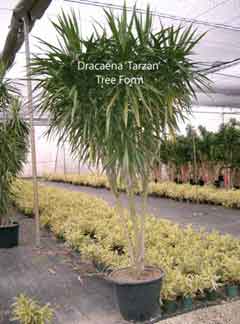
Care Instructions For Watering Your “Red-Edged Dracaena”
When growing indoors, I like to use sub-irrigation on Dracaena plants. Self-watering planters like ones from Lechuza deliver water evenly to the soil and allow Dracaenas to also dry out evenly between refilling the reservoir.
If you’re watering from the top allow the soil to dry out a little between waterings. When the surface of the soil is dry to the touch – water the Dracaena marginata plant thoroughly and allow the excess water to exit through the drainage holes.
What Temperatures Are Best For Marginata?
The Dracaena marginata is much like you – enjoying comfortable room temperatures of 75° degrees Fahrenheit, allowing for this top-notch “plant air cleaner” to remove pollutants like Formaldehyde from the air.
The leaves of any Dracaena over time will grab their share of dust. Clean these house plants regularly and remove the dust by wiping the leaves with a damp cloth.
Most plants you buy for the home will have enough plant food in the potting mix to last a long time – in general, stay away from fertilizing indoor plants but if you must, use a weak liquid fertilizer at 1/4 to 1/3 strength will do.
Feed Dracaena marginata plants when they are actively putting on new growth during the spring and summer growing season.
If the plant’s stems become too long and bare, cut them off at the desired height, and new leaves will soon appear.
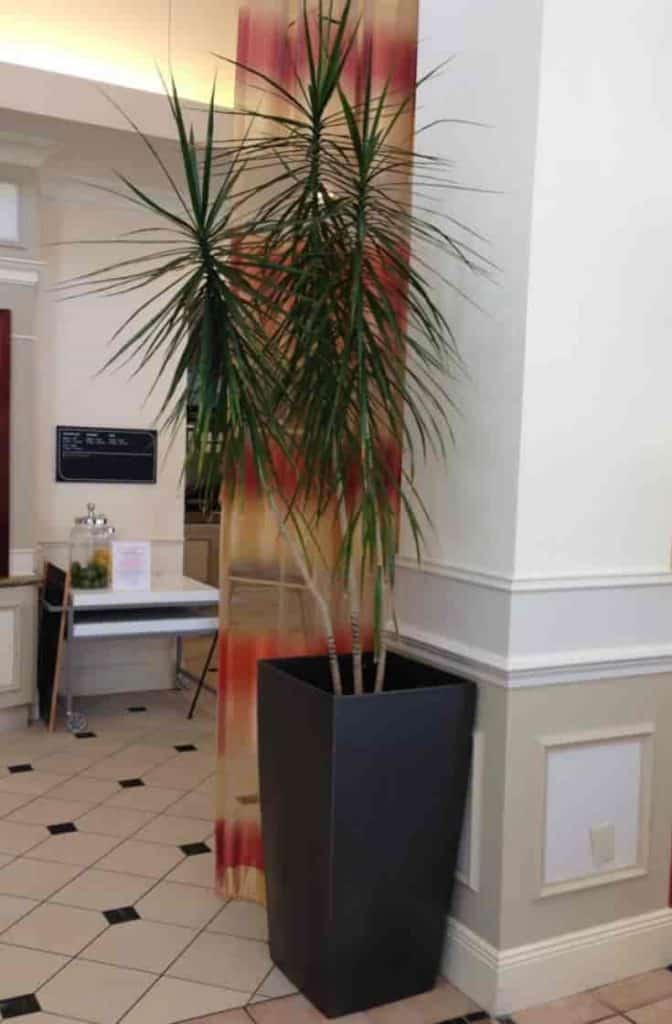 Dragon tree Dracaena marginata used indoors in Alabama hotel lobby.
Dragon tree Dracaena marginata used indoors in Alabama hotel lobby.
Dracaena Marginata Pests Problems?
Fortunately, indoors plant disease is a rare problem with the Dracaena family as a whole. The biggest problem normally comes from improper watering – too much or too little causes brown tips and yellow leaves – that’s why I like sub-irrigation. The next problem comes from pests like mealy bugs or spider mites.
Details on getting rid of mealybugs on Dracaena.
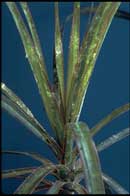 Root rot usually finds its way into the Dracaena problem camp when the potting soil is overwatered on a frequent basis or the potting mix does not drain quickly enough.
Root rot usually finds its way into the Dracaena problem camp when the potting soil is overwatered on a frequent basis or the potting mix does not drain quickly enough.
For most new to houseplant care it’s the overwatering that hurts the plant.
When the humidity gets too low like during the winter months leaf tips can brown. This is where a humidifier can help with plant care.
If your Madagascar Dragon trees suffer from a sudden loss of leaves look for a number of possible causes:
- Exposure to temperature changes
- Cool drafts
- Overwatering or too much water
- Poor drainage (e.g. sitting in a saucer full of water)
- Allowing the soil to dry too much
- Heavy insect infestations
Learn More
If you click this link and make a purchase, we earn a commission at no additional cost to you.
Another reason to stay away from fertilizing is due to fertilizer burn. Just like a lawn can burn with fertilizer so can a Dracaena. The leaf tips and margins can become yellow or burn from over fertilizing.
Dracaenas are also very fluoride sensitive. This often shows up in yellowing or brown tips on the leaves.
Dracaena Marginata Cultivars
‘Tarzan’ USPP #15,065
Dracaena Tarzan New King Of Marginata
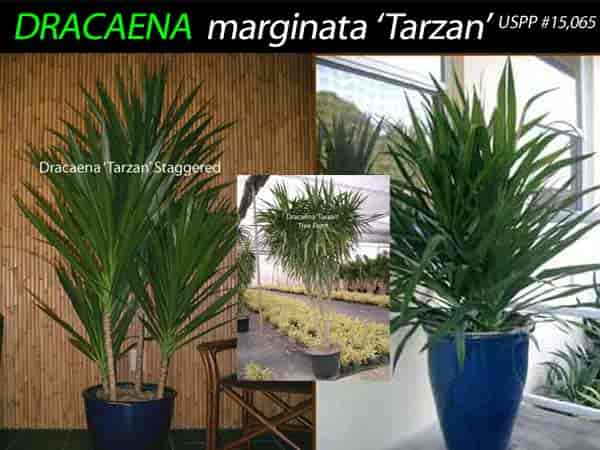 Dracaena marginata Tarzan looks like the new “King” in the Dracaena Marginata world. Dracaena ‘Tarzan’ holds U.S. Plant Patent #15,065 and was discovered in 1998 as a single plant by Sunshine Tropical Foliage in South Florida.
Dracaena marginata Tarzan looks like the new “King” in the Dracaena Marginata world. Dracaena ‘Tarzan’ holds U.S. Plant Patent #15,065 and was discovered in 1998 as a single plant by Sunshine Tropical Foliage in South Florida.
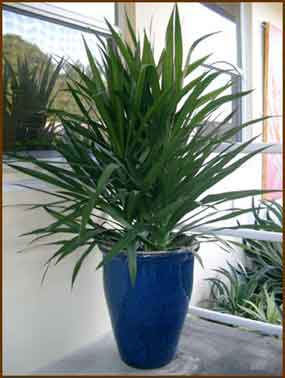 ‘Tarzan’ grows pretty much like a marginata, but its leaves are distinctively wider, longer with a dark purple colored margin.
‘Tarzan’ grows pretty much like a marginata, but its leaves are distinctively wider, longer with a dark purple colored margin.
In lower light levels ‘Tarzan’ will hold more leaves better (more lower leaves) and even grow setting itself apart from the regular marginata.
Here’s a few unique characteristics distinguishing ‘Tarzan’:
- Growth habit – Upright
- Slender stems mature to a woody trunk
- Fleshy leaves, glossy dark green in color with dark purple-colored margins
- Durable with excellent keeping quality with more lower leaves
- Resistant to pests
The care for Dracaena ‘Tarzan’ is like most Dracaenas.
Dracaenas are woody plants and recognized by most “in the know” as great houseplants, perfect choices for indoor environments, and excellent landscaping plants. The popular Dracaena marginata, has many cultivars loved because of their foliage, and Dracaena Tarzan is a new favorite.

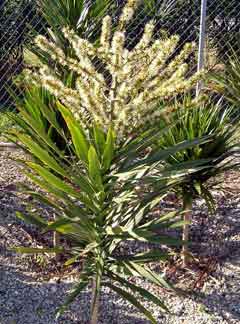 Blooming Dracaena marginataThe upright growth habit of Tarzan is very similar to Marginata. But compared to Dracaena Marginata, it has longer and wider leaves.
Blooming Dracaena marginataThe upright growth habit of Tarzan is very similar to Marginata. But compared to Dracaena Marginata, it has longer and wider leaves.
These fleshy leaves are held much better than Marginata. Each glossy leaf is rich green in color with deep purple colored margins. Tarzan has slender stems that mature into woody trunks.
Dracaena Tarzan grows well in lower light but prefers bright indirect light. Its durability makes it capable for many growers to have Tarzan in many forms – shrub or tree. It is pest-resistant and drought tolerant. This plant thrives well indoors and/or outdoors especially in areas or landscapes with full sun or shade.
Dracaena Tarzan like Marginata
Any King deserves a royal treatment. Fussy and luxurious pampering is needed to satisfy his royal highness. But our King of Marginata proves to be a very easy to grow plant. Any owner of King of Marginata, or simply called, Dracaena Tarzan does not have to fuss very much over this plant.
Tarzan is a distinct cultivar of Dracaena marginata that grows very similar to the Dracaena marginata. But unlike Marginata, Tarzan has upright growth habit with slender stems that give support to the plant’s linear and fleshy leaves. The glossy leaves of Tarzan are dark green in color with deep purple colored margins.
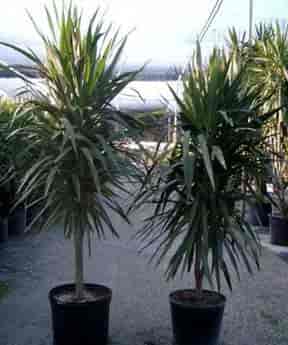 Tarzan just like Marginata can be grown in various forms. It can make a standout accent when used as a tree form.
Tarzan just like Marginata can be grown in various forms. It can make a standout accent when used as a tree form.
As a bush, its leaves would look full and fall less thus making it an excellent centerpiece or as an accent plant to fill up a dull and empty corner.
Our King is very adaptable to normal or almost adverse conditions, requiring little care. For optimum growth make sure that it is put in an area with indirect light. Browning of leaves is less likely to occur if the plant is put in a high humidity environment.
When you see too many yellow leaves dropping from the plant, check your watering habits. It would also help your plant to grow well if it feels a little care from you. So, if possible, check the leaves of your Dracaena Tarzan and make sure that they’re dust-free.
Hail to the new ‘King of Dracaena Marginata’
Dracaena Magenta
 The ‘Magenta’ cultivar gets its name from the almost burgundy or magenta foliage color down the leaf edge.
The ‘Magenta’ cultivar gets its name from the almost burgundy or magenta foliage color down the leaf edge.
The variety is slowly seeing more production, but takes time to build a large enough stock to produce as many different forms as you see in marginata.
‘Magenta’ in my opinion has a ‘softer’ look than the regular marginata variety.
After ‘Tarzan’, ‘Magenta’ would be my second choice.
Dracaena Marginata Tricolor
‘Tricolor’ with its red leaf margins and white band or stripe running down the green leaf has been around for years but never quite caught on in popularity.
Most likely the white band in the leaves requires more light indoors to maintain a healthy plant. This variety will require more light than regular marginata. Also during the production phase I’ve noticed more brown spots on the leaves of Dracaena “tricolor.”
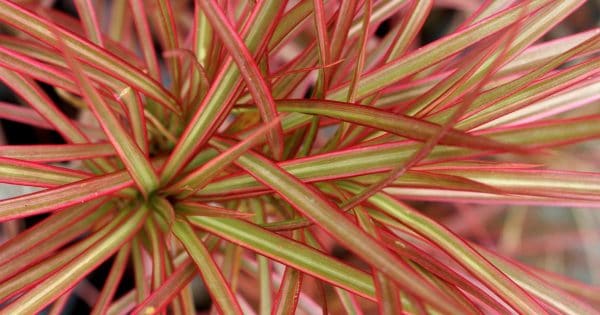 Close Up of Dracaena marginata tricolor leaves
Close Up of Dracaena marginata tricolor leaves
Dragon Tree Dracaena Marginata Colorama
‘Colorama’ similar in appearance and growth to `Tricolor’ except you’ll find red and ivory bands in the central section of the leaf.
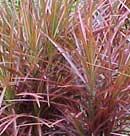 Both ‘Tricolor’ and ‘Colorama’ have less chlorophyll than the common green species. They DO NOT grow as fast and require much more light to live indoors.
Both ‘Tricolor’ and ‘Colorama’ have less chlorophyll than the common green species. They DO NOT grow as fast and require much more light to live indoors.
If you do not have a very bright area for ‘Tricolor’ or ‘Colorama’ dragon tree varieties do not even attempt them indoors.
This versatile, easy care and unique looking plant available in so many forms fits into most any indoor area making it easy to see why the Dracaena marginata is a popular and important plant for use indoors. You can find the Dracaena marginata is almost any nursery or garden center.
Other Dracaena Species Grown For Use Indoors:
- Dracaena Arborea
- Dracaena Fragrans – Corn Plant
- Dracaena massangeana cane
- Dracaena sanderiana – “Lucky bamboo”
- Dracaena deremensis “warneckii” – white with yellow stripes
- Dracaena deremensis “Janet Craig” – all green
- Dracaena reflexa
- Dracaena surculosa – grown mainly for dish gardens
Read our article on available Dracaena types.
NOTE: Dracaena Draco the ‘dragon’s blood’ is grown as a landscape plant.
 Dracaena Marginata Candelabra
Dracaena Marginata Candelabra Dracaena Marginata stump
Dracaena Marginata stump Potted Dracaena Marginata with bends and curves.
Potted Dracaena Marginata with bends and curves.
 Dragon tree Dracaena marginata used indoors in Alabama hotel lobby.
Dragon tree Dracaena marginata used indoors in Alabama hotel lobby.



 Blooming Dracaena marginata
Blooming Dracaena marginata

 Close Up of Dracaena marginata tricolor leaves
Close Up of Dracaena marginata tricolor leaves